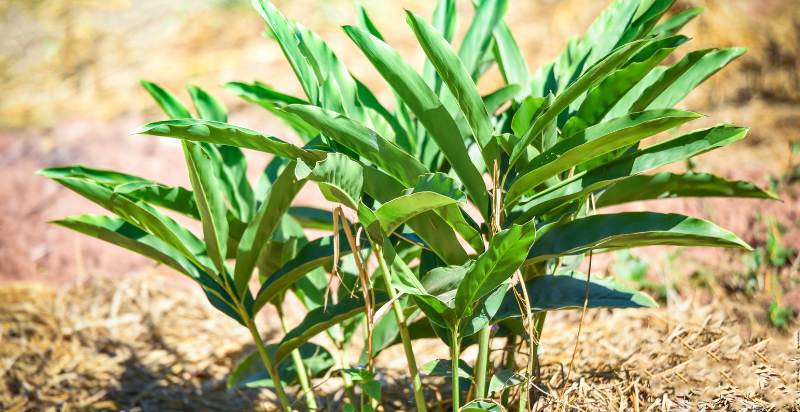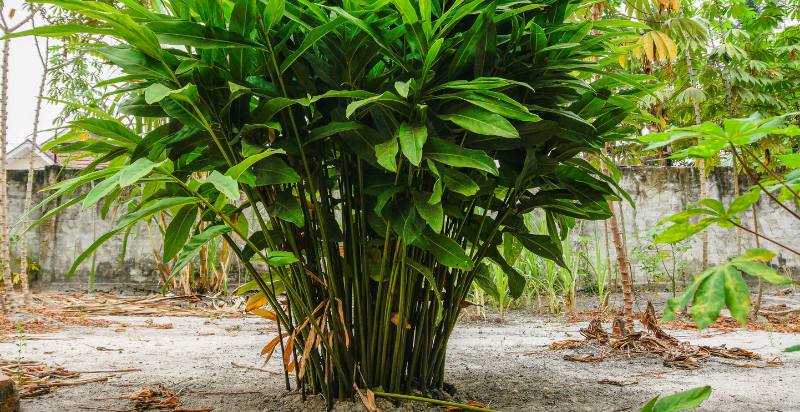Galangal is a rhizome, or underground root stem, related to ginger. It has a fragrant aroma with hints of lemongrass and citrus and a distinct taste that’s slightly spicy and sweet. This ingredient is used in Thai, Indonesian and Malaysian cuisine for its unique flavor. Here is everything you wanted to know about Galangal.
What is Galangal?
Galangal is a rhizome, or underground root stem, related to ginger, turmeric, and cardamom. It is commonly grown in Southeast Asia, especially in Thailand, Indonesia, and Malaysia. The most common types of galangal are greater galangal (Alpinia galanga) and lesser galangal (Alpinia officinarum). Greater galangal is the most widely used, with a stronger flavor and aroma often described as spicy and piney.
History and Origin of Galangal?
Galangal has been used in the cuisines of Southeast Asia for centuries. The earliest records of it date back to the 1300s in China when it was used for medicinal purposes. In Thailand and Malaysia, galangal is known as “lengkuas” and is a key ingredient in many traditional dishes. In Indonesia, it is known as “laos” and is often used to flavor soups and curries.
Types of Galangal?
There are two main types of galangal: greater galangal (Alpinia galanga) and lesser galangal (Alpinia officinarum). Greater galangal is more widely used, as it has a stronger flavor and aroma. It is often available in dried, ground, or new form. Lesser galangal is milder in taste and aroma and is used mainly for soups and curries.
Uses of Galangal:
Galangal is used in various dishes, from curries to soups and stews. It’s also commonly found in paste-like mixtures like curry pastes and sambal, popular condiments in Southeast Asia. When using galangal, it’s usually pounded before being added to dishes. This also helps release its flavor and aroma.
Health Benefits of Galangal:
Galangal has numerous health benefits due to its high levels of vitamins, minerals, and antioxidants. It contains important compounds such as lignans that may help protect against cancer, while its anti-inflammatory properties can help reduce inflammation in the body. It also has antimicrobial and antibacterial properties, which can help protect against infections.
Galangal is a unique and flavorful ingredient used in Southeast Asian cuisines. It’s easy to find and can be used in various dishes. It also has numerous health benefits, making it a great addition to your diet. Whether cooking a traditional Southeast Asian dish or experimenting in the kitchen, galangal is sure to bring your meals to life.
How to Plant Galangal Root?
Galangal root, also known as Thai ginger or Greater galangal, is a perennial herb with aromatic roots that grow underground. It has a spicy, ginger-like flavor and is used to add a unique flavor to many dishes.
Galangal root is an important ingredient in Thai cuisine, as well as in other Southeast Asian cuisines. It’s also used medicinally for its anti-inflammatory properties and can be eaten raw or cooked. Planting galangal roots is simple and has many health benefits.
Instructions
- Choose an area of your garden or a large container to plant the galangal root. Select a spot with well-draining soil, preferably in full sun or partial shade.
- Dig a hole in the soil slightly bigger than the root to give it room to expand. Place the galangal root into the hole and cover it with soil until it’s completely covered but not too tightly packed. Firm down the dirt lightly around its base so that it’s secure in place.
- Water the soil around your newly planted root generously. Keep the soil moist but not soggy. You can add mulch to the soil’s surface to help it retain moisture.
- Fertilize your galangal root every few weeks with a slow-release fertilizer or fish emulsion for best results.
- Check your galangal plant often for signs of pests and diseases such as aphids, fungal spots, or root rot. If you see any pests or diseases, immediately prevent them from spreading.
- Harvest when the leaves start to turn yellow and die back in late summer to early fall (usually between August – October). Dig around the base of the plant carefully and carefully remove the entire root from the soil.
- Peel the outer layer of skin from the root and discard it before using or storing the galangal root. You can store the peeled root in an airtight container in a cool, dry place for up to one month. Alternatively, you can also freeze it for up to 6 months.
By following these simple steps, you can successfully plant and harvest your galangal root that’s fresh and packed full of flavor! Not only is it delicious, but you’ll also benefit from its many medicinal properties.

How to Care for a Galangal Root?
- Water your galangal root plant regularly, keeping the soil moist but not soggy.
- Fertilize your galangal root with a slow-release fertilizer or fish emulsion every few weeks for the best results.
- Check for signs of pests and diseases such as aphids, fungal spots, or root rot and take action if necessary.
- Mulch the area around your galangal root to help retain moisture in the soil and protect it from weeds and other pests.
- Cut any dead foliage at the end of the growing season to encourage further growth in springtime (March – April).
Following these simple steps can keep your galangal root healthy and strong. With proper care and maintenance, you’ll be able to enjoy this flavorful herb for many years to come.

Preventions from Pests and Diseases:
- Remove any weeds or debris from around the base of the galangal root plant to reduce pest and disease infestations.
- Inspect plants regularly for signs of pests or diseases and take action immediately if you spot anything.
- Apply organic pesticides, like neem oil, to control pests and diseases without harming beneficial insects in your garden.
- If necessary, rotate crops every few years to help reduce the spread of common crop-related diseases such as bacterial leaf spots, fungal brown rot, mildew, and stem rusts.
By following these simple preventative steps, you can keep your galangal root in good health all year round! With proper care and maintenance, you’ll be able to enjoy the many benefits of this versatile herb for years to come.

How to Harvest Galangal Roots?
Harvesting galangal roots requires a bit of patience and work. Here are some steps to help you get started:
- Choose an appropriate time for harvesting. Galangal is usually ready for harvest after 3-4 months of planting when it has reached a height of at least 20 cm (8 inches). The best time to harvest is in the morning before the sun becomes too hot.
- Loosen the soil around the root with a hoe or spade before harvesting. This helps ensure you don’t accidentally damage or break off any part of the plant as you dig it up.
- Carefully dig up the entire root system with your hands or a garden fork. Try to ensure you’re not damaging any of the rootlets when digging.
- Clean the harvested roots with water and remove any dirt that might have stuck onto them during harvesting.
- Trim off any remaining leaves, stems, or other plant material from the root before using it in recipes or storing it for later use.
- Galangal can be stored fresh in an airtight container for up to 2 weeks in a cool place (such as a refrigerator). You can also freeze it for up to 6 months if desired.

How to Store Homegrown Galangal?
Galangal root can be stored fresh in an airtight container for up to 2 weeks. It can also be frozen for up to 6 months for longer-term storage. To freeze your galangal root, wash the roots, pat them dry and store them in airtight containers or freezer bags.
Alternatively, you can dehydrate the galangal by slicing it into thin pieces and drying it at a low temperature in a dehydrator or oven. Once dried, store the slices in an airtight container or package them individually into smaller portions that are easy to use later.
You can rehydrate the galangal when needed by soaking it in hot water until softened before using it in recipes.
By following these simple steps, you can easily store your homegrown galangal root for use at a later date. With proper care and maintenance, you’ll be able to enjoy the unique flavor of this delicious herb for many years to come.
How to Use the Galangal Root?
Galangal root has a unique flavor that compliments a variety of dishes. It can be used fresh, dried, or ground into a powder and added to sauces, soups, curries, and stir-fries. In Thailand, it is often boiled with coconut milk to make tom kha gai (chicken in galangal-coconut soup).
The root can also be used in marinades for fish or meat dishes and desserts such as lemongrass pudding or steamed banana cake. The leaves can be steeped in hot water to make a tea that relieves stomach aches and cold symptoms.

Potential Risks from Galangal Root:
Although galangal root is widely used in cooking and has many health benefits, it can also cause some side effects when consumed in large doses or by those who are allergic to the herb. Possible side effects include skin rash, stomach pain, nausea, vomiting, and diarrhea. In rare cases, it may also lead to liver damage.
It is important to note that pregnant women should avoid consuming galangal due to its potential for stimulating uterine contractions. It’s also best to talk with your doctor before taking any herbal supplement, as they may interact with other medications you are taking.
Therefore, it is important to exercise caution when using galangal root and consult a medical professional if you have any concerns. By following these simple tips and paying attention to potential risks, you can enjoy this delicious herb’s many benefits without worry.
Troubleshooting Common Problems with Galangal Root:
Although galangal root is easy to grow, it can sometimes be prone to certain pests or diseases that can damage the plant. It is important to note these problems so they can be addressed quickly before they become major issues.
Common pests associated with galangal include aphids, scale insects, and spider mites. These pests can be treated with insecticides or by introducing beneficial insects such as ladybugs and green lacewings into the garden.
Galangal root is also susceptible to fungal diseases such as black spots, powdery mildew, and downy mildew. The best way to prevent these diseases is to ensure that your plants receive adequate sunlight, air circulation, and water. If you notice signs of disease, treating it immediately with an appropriate fungicide is important.
Conclusion:
Galangal root is a versatile and flavorful herb that can be used in various dishes. When grown in your garden, it’s important to properly store and use the root to remain fresh and flavorful. It’s also important to be aware of potential pests or diseases that can affect the plant and take measures to prevent them. Following these simple tips, you can easily grow and use galangal roots for many years!
With its unique flavor and numerous health benefits, galangal root is an excellent addition to any garden. Not only does it bring out the best in your cooking, but it can also relieve various ailments. By following these simple tips and taking the necessary precautions, you’ll be able to enjoy the many benefits of this delicious herb for years to come!
Happy gardening!
- Everything You Wanted to Know About Red Tamarillos - June 2, 2025
- A Guide to Tulips: Everything You Need to Know & More… - June 2, 2025
- Guanabana: Description, Flavor, Benefits, And Uses - May 27, 2025

1 thought on “What is Galangal? How to Plant, Grow, and Harvest Galangal Root”
Comments are closed.